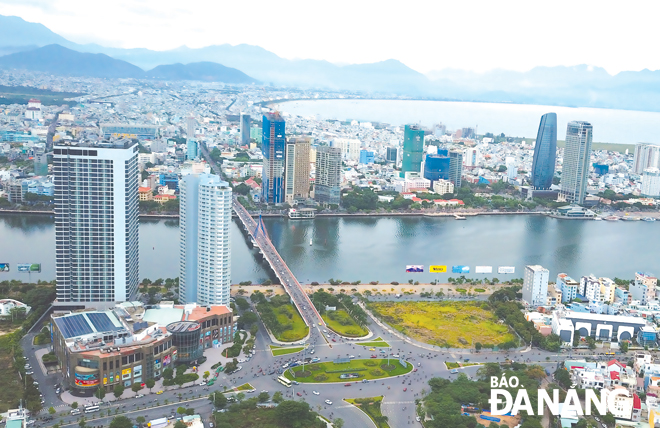PM approves adjustments to the city's socio-economic development planning
Prime Minister Nguyen Xuan Phuc has approved adjustments to Da Nang’s master plan on socio-economic development until 2020 with a vision towards 2030.
 |
| An overview of Da Nang from above |
Under the adjusted master plan, Da Nang is striving to become a world city with smart and green infrastructure and its own distinctive identity. Therefore, the city is making efforts to boost its economic growth in a sustainable manner, improve the quality of life for its residents, ensure security and defence and protect the national sovereignty over its sea and islands.
The city has identified three key drivers of growth: tourism, hi-tech industry and the maritime economy.
In addition, Da Nang is making it more important as a major centre of social and economic activities in Viet Nam and Southeast Asia. The city is targeting to become a major hub of startup and innovation, tourism, trade, financial, logistics, hi-tech industry, information technology, culture and sports, education and training, and healthcare in Viet Nam.
The city will strive to record average annual economic growth of 12% during the 2021-2030 period, with the services accounting for 67-68% of the economic structure, industry and construction 31-32%, and agriculture 1%.
The city’s population is expected to reach approximately 2.5 million. The employment rate is estimated to increase by 5-5.5% a year with the rate of skilled workers exceeding 70% by 2030.
By 2030, 100% of solid waste, and 80% of waste water will be treated, and 100% of local residents in rural areas will have access to clean water. The city’s forest coverage will reach 45%.
Besides, Da Nang will develop tourism services in line with resort properties with a focus on building the Da Nang Bay, and developing seaports and airports in parallel with logistics services.
Efforts will be made to develop the Son Tra Peninsula into a high-class eco-tourism area associated with nature conservation, and make the Da Nang Bay a maritime urban area with its unique identity. Also, downtown areas, shopping streets, restaurants and entertainment areas will be created in an effort to increase tourist arrivals in the city.
Special attention will be paid to developing key tourism products, including MICE (Meetings-Incentives-Conferences-Exhibitions), beach tourism, community-based ecotourism, and spiritual tourism.
 |
| New urban areas on the southern side of the city |
Also, the city will attach the importance to maintaining the harmonious development of trade, finance and banking activities, and increasing the quality of services and products.
With regard to trade sector, Da Nang will continue to maintain its growth momentum of 8% during the year 2020, and between 8.4% and 11% during the 2021-2030 period. This sector is expected to account for 12.9% and 15.4% of the city’s gross regional domestic product (GRDP) in 2020 and 2030 respectively.
Da Nang will pay a heed to avoiding conflicts between industrial and tourism development targets, while developing environmentally-friendly industrial projects and eco-industrial zones. It will put forward incentives to attract more potential investors, especially those in the world’s Top 500, as well as promote the use of information technology in business and production activities.
Many hi-tech agricultural zones will be also developed, whilst offshore fishing activities will be conducted in a comprehensive and sustainable manner.
The city will also promote the development of logistics services and infrastructure for fisheries in order to realise its goals of becoming a major fishing centre in the central region.
It is predicted that, during the 2021-2030 period, the growth rate of the agricultural sector will reach 2.2%, accounting for about 1% of the city’s GRDP by 2030.
PM has also granted permission for Da Nang to carry out some of its priority projects. Included are the building of Lien Chieu Port, Hoa Phuoc agricultural wholesale market, the Da Nang General Hospital No 2 in Hoa Vang District’s Hoa Quy Commune, the Ngu Hanh Son Cultural and Historical Park, the Hoa Lien Water Plant, and mass transit system featuring Bus Rapid Transit (BRT), metros and tramways; the relocation of the city’s railway station; and the upgrade of the Tho Quang Fishing Wharf, the Maternity and Paediatrics Hospital, the Con Market, the Da Nang Biotechnology Centre and the Hi-Tech Park.
By TRIEU TUNG - Translated by MAI DUNG